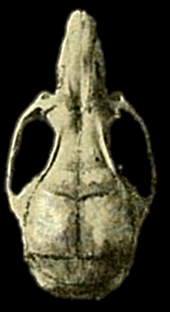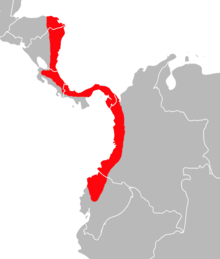Transandinomys
| Transandinomys | |
|---|---|

| |
| Skull of Transandinomys bolivaris from Cerro Azul, Panama, seen from above[1] | |
| Scientific classification | |
| Domain: | Eukaryota |
| Kingdom: | Animalia |
| Phylum: | Chordata |
| Class: | Mammalia |
| Order: | Rodentia |
| Family: | Cricetidae |
| Subfamily: | Sigmodontinae |
| Tribe: | Oryzomyini |
| Genus: | Transandinomys Weksler, Percequillo, & Voss, 2006 |
| Type species | |
| Oryzomys talamancae J.A. Allen, 1891
| |
| Species | |

| |

| |
| Distribution of Transandinomys bolivaris (top) and T. talamancae (bottom) in Central America and northwestern South America. | |
Transandinomys is a
Transandinomys bolivaris and T. talamancae are medium-sized, soft-furred rice rats. The upperparts—brownish in T. bolivaris and reddish in T. talamancae—are much darker than the whitish underparts. Both species are characterized by very long
Taxonomy
The first species of Transandinomys (from Neo-Latin transandinus: "transandean", i.e., "crossing or beyond the
In 2006, Marcelo Weksler published a broad
Description
Transandinomys species are medium-sized, soft-furred rice rats.
The fur is brownish (T. bolivaris) or reddish (T. talamancae) above and lighter below, appearing whitish, but the hairs on the underparts have gray bases.
Females have four pairs of
Skull and teeth
| Species | Head and body | Tail | Hindfoot | Ear | Mass |
|---|---|---|---|---|---|
| T. bolivaris | 100–140 | 99–130 | 27–33 | 16–21 | 39–75 |
| T. talamancae | 105–146 | 105–152 | 28–32 | 17–24 | 47–74 |
| Measurements are in millimeters, except mass in grams. | |||||
In the skull, the rostrum (front part) is long. The
The
The upper incisor is
Distribution, ecology, and behavior
The distribution of Transandinomys extends from eastern Honduras through Nicaragua, Costa Rica, Panama, and Colombia south and east to southwestern Ecuador and northern Venezuela, generally west and north of the Andes.[32] The ranges of the two species overlap but are distinct. T. bolivaris occurs from Honduras mainly on the Caribbean side of Central America south to western Colombia and northwestern Ecuador, up to 1800 m (5900 ft) above sea level.[33] T. talamancae, which is found up to 1525 m (5000 ft) above sea level, is less widely distributed in Central America, as it is not known further north than northwestern Costa Rica, but is more widely distributed in South America, occurring into far southwestern Ecuador and northern Venezuela. It has also been recorded south of the Venezuelan Andes, in the narrow strip of forest between the Llanos and the mountains.[34] Both species are forest rats, but whereas T. bolivaris is restricted to humid forest formations, T. talamancae apparently is more tolerant of drier forest, which explains its wider South American distribution.[35]
Both species live on the ground, are active during the night, are solitary, and feed mainly on fruits and seeds, but may also eat herbs and insects. They build nests of leaves and branches among vegetation, for example in a tree hollow, or under rocks.
Conservation status
Transandinomys talamancae is common or even abundant, but T. bolivaris generally occurs less frequently.
Notes
- ^ Descriptions of tail coloration in the latter species vary;[19] see Transandinomys bolivaris: Description.
References
- ^ Goldman, 1918, plate II
- Perseus Project.
- ^ Allen, 1890, p. 193
- ^ a b c d e f g Weksler et al., 2006, p. 25
- ^ Allen, 1901, p. 405
- ^ Goldman, 1918, p. 73
- ^ Musser and Carleton, 2005, p. 1155
- ^ Musser and Carleton, 2005, p. 1146
- ^ Weksler, 2006, figs. 34–39
- ^ Weksler, 2006, pp. 75–77
- ^ Weksler, 2006, pp. 1, 10; Weksler et al., 2006, p. 1, table 1
- ^ Musser and Carleton, 2005
- ^ a b c d Tirira, 2007, p. 198
- ^ Musser et al., 1998, pp. 125, 167, 169; Weksler et al., 2006, p. 13
- ^ Weksler et al., 2006, pp. 13, 15, 25–26
- ^ Musser et al., 1998, p. 13
- ^ Weksler et al., 2006, p. 15
- ^ Musser et al., 1998, pp. 125, 143, 167, 169
- ^ Musser et al., 1998, p. 123; Weksler et al., 2006, p. 25; Tirira, 2007, p. 199; Reid, 2009, p. 208
- ^ Musser et al., 1998, p. 124; Weksler, 2006, pp. 17, 19
- ^ Steppan, 1995, table 5
- ^ Musser et al., 1998, p. 125
- ^ Musser et al., 1998, table 13
- ^ Reid, 2009, p. 208
- ^ Musser et al., 1998, p. 125; Weksler, 2006, pp. 43–44
- ^ Musser et al., 1998, pp. 140, 143; Weksler et al., 2006, p. 14
- ^ Weksler, 2006, pp. 48–49
- ^ Weksler et al., 2006, p. 14
- ^ Musser et al., 1998, pp. 140–141; Weksler et al., 2006, p. 14
- ^ Musser et al., 1998, p. 142; Weksler, 2006, pp. 42–43; Weksler et al., 2006, p. 26
- ^ Goldman, 1918, plate VI
- ^ Weksler et al., 2006, p. 24; Musser et al., 1998, p. 113
- ^ Musser et al., 1998, p. 113
- ^ Musser et al., 1998, p. 157; Musser and Carleton, 2005, p. 1255
- ^ Musser et al., 1998, p. 157; Weksler et al., 2006, p. 24
- ^ Tirira, 2007, p. 199
- ^ Fleming, 1971, p. 40
- ^ Fleming, 1971, table 11
- ^ Brennan and Yunker, 1966, pp. 262, 266; Tipton and Méndez, 1966, pp. 323, 330; Tipton et al., 1966, p. 42; Durden and Musser, 1994, p. 30
- ^ Tirira, 2007, p. 200; Reid, 2009, p. 208
- ^ Anderson et al., 2008; Gómez-Laverde et al., 2008
Literature cited
- Allen, J.A. 1891. Descriptions of two supposed new species of mice from Costa Rica and Mexico, with remarks on Hesperomys melanophrys of Coues. Proceedings of the United States National Museum 14(850):193–196.
- Allen, J.A. 1901. New South American Muridae and a new Metachirus. Bulletin of the American Museum of Natural History 14:405–412.
- Anderson, R.P., Aguilera, M., Gómez-Laverde, M., Samudio, R. and Pino, J. 2008. Transandinomys talamancae. In IUCN. IUCN Red List of Threatened Species. Version 2009.2. <www.iucnredlist.org>. Downloaded on June 26, 2010.
- Brennan, J.M. and Yunker, C.E. 1966. The chiggers of Panama (Acarina: Trombiculidae). Pp. 221–266 in Wenzel, R.L. and Tipton, V.J. (eds.). Ectoparasites of Panama. Chicago: Field Museum of Natural History.
- Fleming, T.H. 1971. Population ecology of three species of Neotropical rodents. Miscellaneous Publications of the Museum of Zoology, University of Michigan 143:1–77.
- Goldman, E.A. 1918. The rice rats of North America. North American Fauna 43:1–100.
- Gómez-Laverde, M., Rivas, B., Timm, R. and Pino, J. 2008. Transandinomys bolivaris. In IUCN. IUCN Red List of Threatened Species. Version 2009.2. <www.iucnredlist.org>. Downloaded on June 26, 2010.
- Musser, G.G. and Carleton, M.D. 2005. Superfamily Muroidea. Pp. 894–1531 in Wilson, D.E. and Reeder, D.M. (eds.). Mammal Species of the World: a taxonomic and geographic reference. 3rd ed. Baltimore: The Johns Hopkins University Press, 2 vols., 2142 pp. ISBN 978-0-8018-8221-0
- Musser, G.G., Carleton, M.D., Brothers, E.M. and Gardner, A.L. 1998. Systematic studies of oryzomyine rodents (Muridae: Sigmodontinae): diagnoses and distributions of species formerly assigned to Oryzomys "capito". Bulletin of the American Museum of Natural History 236:1–376.
- Reid, F. 2009. A Field Guide to the Mammals of Central America and Southeast Mexico. 2nd edition. Oxford University Press US, 346 pp. ISBN 978-0-19-534322-9
- Steppan, S.J. 1995. Revision of the tribe Phyllotini (Rodentia: Sigmodontinae), with a phylogenetic hypothesis for the Sigmodontinae. Fieldiana Zoology 80:1–112.
- Tipton, V.J. and Méndez, E. 1966. The fleas (Siphonaptera) of Panama. Pp. 289–385 in Wenzel, R.L. and Tipton, V.J. (eds.). Ectoparasites of Panama. Chicago: Field Museum of Natural History.
- Tipton, V.J., Altman, R.M. and Keenan, C.M. 1966. Mites of the subfamily Laelaptinae in Panama (Acarina: Laelaptidae). Pp. 23–82 in Wenzel, R.L. and Tipton, V.J. (eds.). Ectoparasites of Panama. Chicago: Field Museum of Natural History.
- Tirira, D. 2007. Guia de campo de los mamíferos del Ecuador. Quito: Ediciones Murciélago Blanco, publicación especial sobre los mamíferos del Ecuador 6, 576 pp. (in Spanish). ISBN 9978-44-651-6
- Weksler, M. 2006. Phylogenetic relationships of oryzomyine rodents (Muroidea: Sigmodontinae): separate and combined analyses of morphological and molecular data. Bulletin of the American Museum of Natural History 296:1–149.
- Weksler, M., Percequillo, A.R. and Voss, R.S. 2006. Ten new genera of oryzomyine rodents (Cricetidae: Sigmodontinae). American Museum Novitates 3537:1–29.
External links
 Media related to Transandinomys at Wikimedia Commons
Media related to Transandinomys at Wikimedia Commons Data related to Transandinomys at Wikispecies
Data related to Transandinomys at Wikispecies


